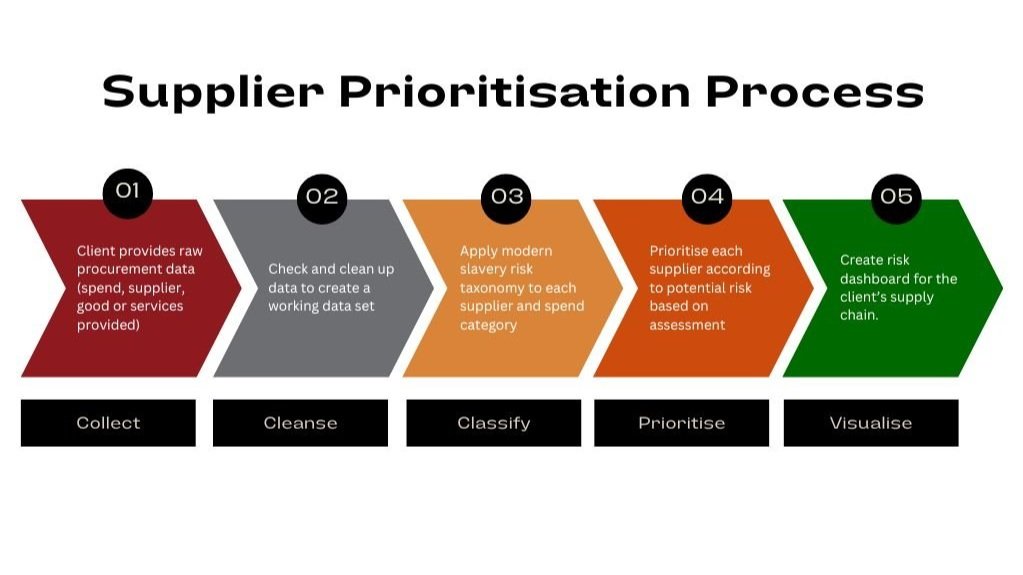Focusing risk management through supplier prioritisation
A question we have heard many times over the years is “Which of our suppliers do we need to assess for modern slavery risk?”
To date, we’ve analysed over $50 billion of procurement spend and over 5,000 suppliers to Australian reporting entities – that’s a lot of number crunching! Our proven method for supplier risk prioritisation focuses on assessing modern slavery risks by considering rmodern slavery risk indicators including geography, industry sector, commodity, and workforce profile. We have honed our process to deliver practical insights into potential modern slavery risks for our clients, avoiding vague or generalised comments about possible issues.
While potential risk may vary between clients in different industry sectors, for example, the oil and gas sector compared to security providers or manufacturing companies, on average our assessments find between 40 to 60% of high spend suppliers are potentially high risk for modern slavery.
Prioritising suppliers based on potential risk enables companies to focus resources on where their supply chain is most exposed and maximise their return on investment from a risk management perspective. This proven process enables companies to demonstrate continuous improvement (a key principle underpinning the Modern Slavery Statement reporting process) and track potential risk trends year on year. This enables companies to refine risk management strategies to address new and emerging modern slavery supply chain risks.
The prioritisation process also informs enhanced due diligence programs – another well-established service we provide to our clients.
Unveiling Insights: Key Findings and Customised Solutions
In response to the findings of supplier prioritisation processes, we have tailored more than 100 supplier questionnaires for our clients across a diverse range of indstry sectors including renewables, mineral and extractive industries, oil and gas, medical consumables, consumer goods, finance, clothing and apparel, ICT, health, security services, and food & beverage. Our global reach extends to Brazil, South Korea, China, India, Bangladesh and across Southeast Asia.
We have conducted hundreds of supplier deep dive risk assessments and identified significant, salient human rights and sustainability risks for our clients. Our process emphasises the positive engagement of suppliers by positioning the enhanced due diligence program as a ‘value-add’ to their business. This reframing and education contributes to a 95% return rate on our self-assessment questionnaires.
We have developed over 220 Corrective Action Plans (CAPs) and have provided close to 3,600 tailored improvement recommendations to national and international suppliers to our clients.
Developing the capacity of contract managers to engage suppliers and work through CAPs has been a major focus of our work. We recently developed guidelines to assist contract managers oversee the corrective action planning process more effectively and track progress more consistently.
Insights Driving Change: Key Gaps in Modern Slavery Risk Management
By reviewing the many corrective action plans we have prepared for our clients’ suppliers, we have identified commonalities in critical risk management gaps among suppliers operating in Australia and internationally:
Grievance & remedy processes: Suppliers either do not have whistleblower policies or processes in place or are unable to provide evidence of these processes. Most do not have effective and documented victim-focused remedy pathways in place to respond to instances of modern slavery.
Risk assessment: Operational and supply chain risk assessment processes remain largely unclear, with the scope, focus and number of assessments undertaken not clarified or substantiated.
Policy framework: Many of the supplier we have assessed have limited modern slavery due diligence systems or processes in place, do not have standalone modern slavery policies and do not reference modern slavery / human rights in other existing policies, procedures or codes of conduct.
Our most common recommendations have included:
Update Systems and Policies: Revise existing systems, policies, and procedures to better address modern slavery and human rights issues. This includes enhancing grievance mechanisms, HR systems, worker protections, internal monitoring, and supplier contracts.
Engage and Educate Stakeholders: Incorporate modern slavery training into internal programs (e.g., induction) and engage high risk suppliers and other key stakeholders where possible. Conduct a training needs analysis to identify who requires modern slavery and human rights trinaing and the most effective training methods.
Integrate Risk Assessment and Reporting: Embed modern slavery risk assessments into the enterprise risk frameworks and management systems. This involves integrating modern slavery or broader sustainability risk assessments into supplier onboarding processes, prioritising risks, aligning with QA or WHS processes, and including these issues in supplier audits and as an agenda item in structured audit and risk committee meetings.
Develop systems and processes to manage modern slavery risks: This includes establishing supplier engagement strategies, audit protocols, risk assessment frameworks, and grievance and remedy systems to improve the assessment and management of operational and supply chain risks.



